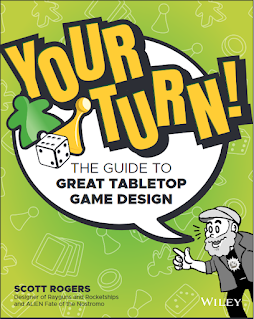As an action figure collector, ToyFair is a highly anticipated event. Held in New York City in February, my news feed usually is crammed with excited posts from fellow collectors about the latest and greatest toys. It doesn't help that many of my friends work in the toy industry. Needless to say, Toy Fair weekend is always an exciting time.
As a member of the board game community, I always want to know about the latest and greatest board games too. Many of the same companies that make toys make board games and they even display them at Toy Fair. However, I find that the same sites that I rely on for board game news don't usually cover Toy Fair. After a little digging around, I decided to post some of the more exciting board games shown at Toy Fair.
Villainous: Wicked to the Core
Leaked a few days before the show, the publishers of the award-winning game Villainous announced an expansion with three new characters: The Evil Queen from Snow White, Hades from Hercules and Dr. Facilier from the Princess and the Frog. Some pretty cool character choices and I'm curious to see how they play. (I'm still hoping for the Hatbox Ghost from Disneyland's Haunted Mansion.) Villainous: Bad to the Core is due out in March.
Horrified
As a fan of horror board games, I was excited to see Ravensburger announce Horrified, a board game based on Universal's "Dark Universe" franchise. There was no game board or components on display, but the press blurb infers that players are the pitch-fork and torch wielding mob who is trying to uncover which Universal horror movie monster (Frankenstein, Bride of Frankenstein, Creature from the Black Lagoon, Dracula, Wolf Man, Mummy and the Invisible Man) is terrorizing the village. I'm still wondering how they are going to do a mini of the Invisible Man... Horrified is due out in August.
Jaws
Ravensburger seems to be going after licenses with a vengeance this year. I don't know how their Jaws game will be different from 2017's Shark Island but they do mention that one of the players gets to play as the shark! Jaws is due out in June - just in time for beach weather.
Wacky Racers
When publisher CMON announced their next game, Wacky Racers, it was a bit of a departure for the company known for Blood Rage, Zombicide and Hate. Based on the 60's cartoon of the same name, players create card based tracks on which to race their highly detailed minis around. Wacky Racers will be available for pre-order this March with an April release.
One Key
From the creators of Mysterium comes this game about finding a missing key by guessing what you don't know. A family game of word association, One Key is due to come out in June.
Trellis
Breaking Games' tile placement game of zen blossoms and vines was on display at Toy Fair. Players race to be the first to play all their flowers first in this cascade of color and fun for 2-4 players. You can buy Trellis in February.
Planet
This game from publisher Blue Orange introduces a unique mechanism - a magnetized dodecahedron on which tiles are placed to create a planet's surface. Evolve terrain and nurture lifeforms to gain points. Planet is available in May.
Tentacle Town
An island is under attack by a swarm of tentacles and only you (and your friends) can stop them! This game from Monster Fight Club looks adorable and comes out "later this year".
Ship Shape
Despite it's cover, Calliope games, the creators of Ship Shape, want you to know that it is NOT about pirates. Instead you are a smuggler hiding cargo from the authorities. Designed by Rob (Betrayal Legacy) Daviau, looks to be nautical fun for everyone! Ship Shape is due out in June.
Spymaster
Another title in Calliope's Masters of Game Design series, Spymaster has players manipulate agents around the world, using valuable intelligence to complete missions. Crucial choices, daring actions, and perfect timing will allow your agency to manipulate the world…and win the game! Spymaster is due out "soon".
Challenge of the Superfriends
Based on the classic 1970's cartoon, this card game by Cryptozoic Entertainment casts the players as classic DC Universe heroes battling against the Legion of Doom. This card game uses the fast-paced Gryphon system. If you love superheroes as much as I do, you'll want to pick up Challenge of the Superfriends in April.
Dungeons and Dragons Stranger Things edition
Transmedia! Hasbro announced a Dungeons and Dragons starter set that is "written" by the character Mike from the Netflix show Stranger Things. Included is dice, character sheets, a manual and adventure and a mini of the Demogorgon (not that Demogorgon). Dungeons and Dragons Stranger Things edition will be released in May.
Trivial Pursuit: Stranger Things: Back to the 80's
Speaking of Stranger Things, Hasbro is releasing a version of the 80's classic Trivial Pursuit - however unlike the original version (released in 1981) or the "Totally 80's" edition (2005), this version comes complete with an "Upside Down" board which, I don't know, allows you to challenge the Demogorgon to trivia matches? Trivial Pursuit: Stranger Things: Back to the 80's is due out in May.
Star Wars Escape from the Death Star Game
The biggest news from Toy Fair isn't that Hasbro is re-releasing the vintage game Star Wars Escape from the Death Star (2016's Clue: Star Wars is a better game) but that the game comes with an action figure that Star Wars fans have been wishing for since 1978 - Grand Moff Tarkin! This is the first time that a "classic Kenner" style figure has been released since the line ended in 1986!! Star Wars Escape from the Death Star Game (and that sweet Tarkin figure) is due out in May.
As you can see, there are lots of great games coming out soon! Start saving up now!

































